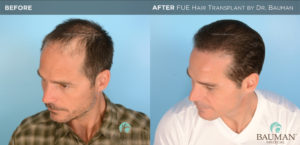By Alan J. Bauman, MD, ABHRS

But don’t worry, just because you may have inherited the hair loss gene, doesn’t mean your follicles will be lost forever.
With Father’s Day upon us, it’s a good time to talk about how advanced techniques for hair follicle harvesting and transplantation differ from “your father’s hair transplant.” Unlike the artificial looking “hair plugs” of the past, these new techniques, combined with the artistic skills of the right surgeon, today’s comfortable, less invasive hair transplants consistently produce undetectable, permanent, natural-looking results.
If you are concerned that you have inherited your father’s tendency toward failing follicles, here is a look at some of the most advanced surgical technology that can help save you from settling for your dad’s “follicular fate.”
SmartGraft FUE:
SmartGraft is an FDA-cleared mechanical, minimally-invasive surgical hair transplant instrument that works like an extension of the surgeon’s hand, allowing the removal of individual follicular units from the donor area located at the back of the patient’s scalp which are then implanted into the bald areas. This means no scalpels, sutures, or staples for the patient in the donor area – leaving absolutely NO linear scar. SmartGraft also has an on-board graft collection and storage system that preserves grafts within a carefully controlled environment for optimal hair growth rates and quality.
ARTAS Robotic-Assisted
FUE System:
The FDA-cleared ARTAS robot is a state-of-the-art medical device that assists in hair transplant surgery by helping to safely and effectively extract intact hair follicles for transplantation using the FUE technique. The robot’s sophisticated micron-level precision allows patients to benefit from an unprecedented level of safety; accuracy, efficiency, and comfort during their hair transplant procedure. The system also features artificial intelligence and stereovision sensors to detect and analyze follicular units — calculating density, exit-angles, orientation, and location to then proceed with precision robotic graft harvesting based on algorithms programmed by the surgeon.
NeoGraft FUE:
The original “game-changing” device for Follicular Unit Extraction is still in use today to help surgeons extract grafts from the Donor Area without leaving behind a tell-tale linear scar. Just be sure your surgeon is an experienced full-time hair restoration physician, not just someone who’s added NeoGraft to a full menu of cosmetic services.
While these transplant procedures can provide patients with natural-looking results, it is still imperative to do your homework when researching a surgeon. One of the biggest problems with hair transplants is that many unqualified, inexperienced doctors offer this procedure and/or perform procedures infrequently. The risks for hair transplant patients include increased discomfort, surgical complications, infections, scarring, poor density and unnatural looking results. When looking for a hair transplant surgeon, make sure you consult with an experienced minimally-invasive hair restoration physician — someone who specializes exclusively in the medical diagnosis, treatment and tracking of hair loss and performs FUE hair transplantation on a daily basis.
The bottom line is, regardless of how the hair follicles are harvested, the critical step for naturalness is the artistry of the surgeon involved. Patients, therefore, should not choose their surgeon based on the tool they use, but more so on their experience and artistic ability. Do your research, ask questions, look at before-and-after pictures, and don’t be afraid to ask for patient testimonials. To find a qualified hair restoration specialist, start by visiting the American Board of Hair Restoration Surgery (ABHRS), International Alliance of Hair Restoration Surgeons (IAHRS) or the International Society of Hair Restoration Surgery (ISHRS).
For more information on what kind of results you might achieve with an advanced FUE hair transplant, please visit www.baumanmedical.com or call 561-220-3480.
Bauman Medical
Hair Transplant and Hair Loss Treatment Center
1450 S Dixie Hwy
Boca Raton FL 33432-7359
Toll Free: 1-877-BAUMAN-9
Tel: 561-394-0024
Fax: 561-394-4522
www.baumanmedical.com
Check Also
WHAT IS MY CIRCADIAN RHYTHM AND WHY DOES IT MAKE ME FEEL SO “OFF”
By Renee Chillcott, LMHC Have you heard terms such as “biological clock” or “biorhythms”, or …
 South Florida Health and Wellness Magazine Health and Wellness Articles
South Florida Health and Wellness Magazine Health and Wellness Articles




